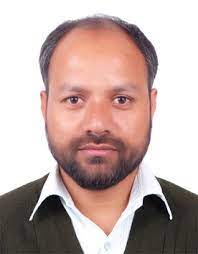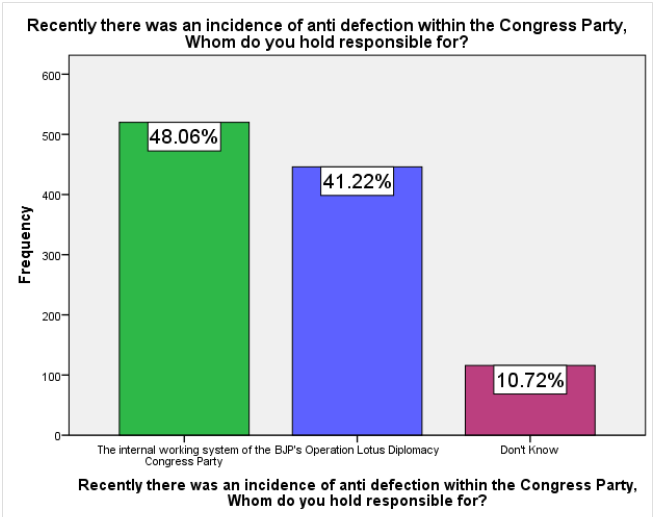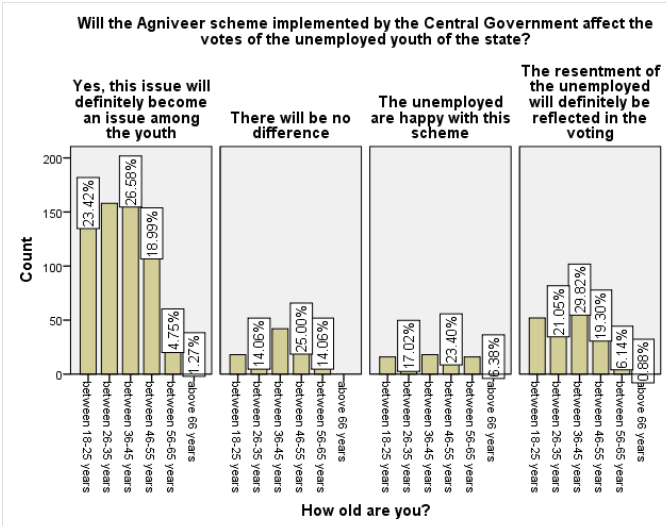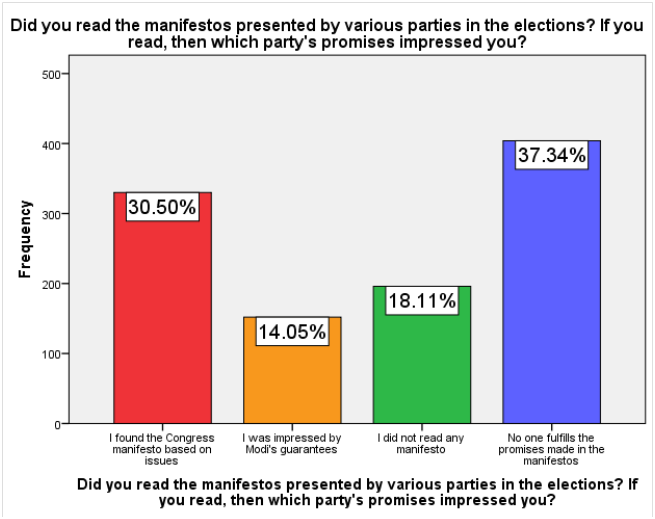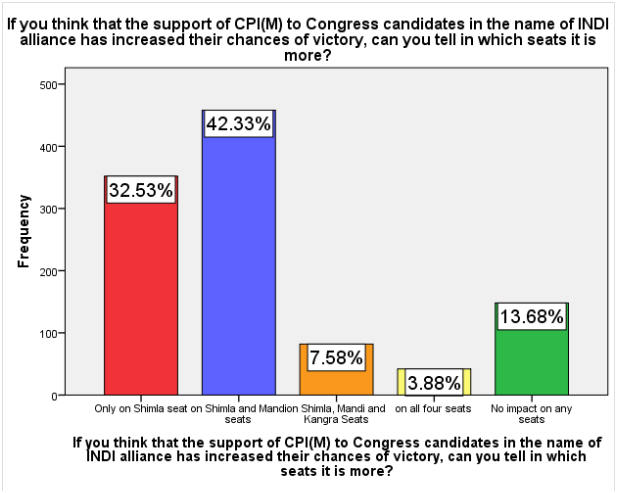Survey on General Election-2024: Himachal Pradesh
About
the survey: It was an online survey conducted
in Himachal Pradesh only to know the opinion of voters about their voting behaviour
in the four parliamentary constituencies Shimla, Kangra, Mandi and Hamirpur. It
was an independent and voluntary survey conducted by two researchers namely Dr.
Baldev Singh Negi who is working at Himachal Pradesh University, Shimla and Dr.
Devender Sharma, working at Government Degree College, Chail Koti, Himachal
Pradesh.
The
sample size of the survey was 1082 to understand the voting
behaviour on the basis of the opinion of youth, women and employees on the
issues like, manifestoes issued by different political parties, leaders/star
campaigners’ influence, impact of INDI Alliance campaign, political turmoil’s
and finally the winning position of parties.
Age wise
27.4 percent respondents were in the age group of 36-45, followed by 22.2
percent from 26-35 age group, 21.6 percent from 18-25 age group, 20.1 percent
from 46-55 age group, between 56-56 year of age group there were 7.2 percent
and above 66 years there were 1.5 percent. This shows that most of the respondents
(71.2 percent) were from middle age group up to 45 years.
The
socio-economic background of
the respondents’ shows that, the survey was comprised of 63.4 percent general, 16.1
percent scheduled caste, and 15.2 percent Scheduled tribe and 5.4 percent were
from the category of OBCs, which is the reflection of inclusivity of the sample.
In this survey there was no respondent without formal literacy rather 88.2
percent respondents were having their qualification graduation and more than
that. However, 11.8 respondents were having their education till higher
secondary level. This survey included 44.9 percent employees, 25.1 percent
students, 9.2 percent farmers, 3.3 percent businessman and there were 17
percent respondents who were from other professions.
The analysis on the different questions asked in
this survey is as under:
1. The
question that which issue is going to dominate the 2024 general elections in
Himachal Pradesh? Answering this question, 53.79 percent respondents stressed
on unemployment, which is the most pressing demand of the youth in Himachal. Followed
by unemployment, Inflation came out as the issue for 18.30 percent. However, 8
percent respondents said Ram Mandir is going to be an issue in this election. (Fig-1) If we analyse the youth data,
63 percent says unemployment is the dominating issue in this election (Fig-2).
2. There
was a question related to the turmoil occurred due to defection with in
congress party. It was asked that whom do you think was responsible for that
upheaval? Whether it was internal conflict or it was BJP’s operation lotus? 48.1
percent respondents considered internal working of congress party responsible
for this incident, there were 41.2 percent respondent’s reasoned BJP’s
operation lotus diplomacy. However, a considerable opinion (10.7 percent) was
neutral. So there was mixed opinion on that question (Fig-3).
3. When
a question was asked that whether this election is localised on Himachaliyat
or Modi wave has wiped out local issues of the state? 61 percent respondents
rejected Modi wave and said people are going to vote on local issues. However,
24.6 percent respondents still believe that Modi wave will dilute all local
issues on the ground and 4.1 percent chose other (Fig-4).
4. A
devastating natural calamity in the form of flash floods occurred in the state
last year caused more than 150 deaths and estimated total loss amounts to Rs.
10,000 crore. When it was asked that State government demanded from the centre
to declare this natural calamity a national disaster, and centre refused, will
this going to be an issue in the election? 49.2 percent respondents said this
issue is going to be a pressing one and 23.8 percent respondents denied. Apart
from this 27 percent said that there will be the impact of this issue but not
to that extent (Fig-5).
5. On
the question whether Kisan Aandolan has any impact on the mind of peasant
voters in Himachal, while voting for Lok Sabha? 33.5 percent said yes while 38.6
percent respondents said since the farmers of Himachal did not have direct
participation in the protests therefore there is no influence and 27.9 percent
directly denied its impact in the state (Fig-6).
6. OPS
have led a very significant role in the state assembly elections-2022. It was
asked whether in this Lok Sabha election OPS will be a factor or not? 49.4
percent said yes because of fear of losing pension if BJP comes in power. Only
16 percent rejected this fear and impact of this issue in this election. Apart
from this 34.2 respondents also admitted that there will be an impact but not
like it was in the previous assembly elections (Fig-7). Out of total employees respondents 54.7 percent said that
OPS is an issue in this election, not only this out of total (534 respondents
who said this is an issues) 21 percent were students, 9 percent were farmers
and 3.4 percent was businessman (Fig-8).
7. Agnipath
scheme which is one of the major issues among youth of north India as political
analysts feel. The question was asked whether in this election it was an issue
or not? 58.4 percent respondents accepted that this is a major issue among the youth
(Fig-9). Those who said that Agnipath scheme is an issue (632 respondents)
among them 75 percent were up to the age group of 45 years as young voters (Fig-10).
8. On
the question of corruption particularly electoral bonds as an issue in this
election in Himachal Pradesh 47.50 percent respondents accepted it as an issue however
22 percent respondents feels that BJP and 7.6 percent says congress is going to
be damaged by this issue. A significant (22.92 percent) thinks that this is not
an issue (Fig-11).
9. Is
Ram Mandir as an issue in this election? 40.85 percent respondents said in
Himachal Pradesh, people have faith in local deities therefore; Ram Mandir has
not that much impact on the behaviour of voters. However, 33.83 percent
respondents said being a Hindu majority state Ram Mandir will impact the
voters. 25.32 percent respondents rejected this issue as non-essential issue (Fig-12).
10. Whether
this election is going to be based on some regional issues like article 118 and
development of Pahari language, 56.19 percent respondents said, people do not
have enough understanding of these issues. 28.10 percent respondents feel that
these issues should be there in mind of people while going out for vote (Fig-13).
11. On the question of religious polarization as
an issue in this election 62.66 percent respondents rejected it thoroughly but
25.51 percent respondents feel that in last few years religious polarization
has entered into the social life of Himachal and this is also going to be
impacted the polls (Fig-14).
12. On
the question of slogans of INDI alliance, as per this alliance of more than 24
parties present parliament election is for saving constitution and democracy,
53.05 percent respondents felt convinced and 33.83 percent respondents rejected
this slogan as useless (Fig-15).
13. On
the question, which of political parties’ manifesto do you trust? 37.3 percent
respondents said no political party fulfils its promises mentioned in their
manifestoes. 30.5 percent shown faith on congress party’s guarantees. And 14
percent shown faith on Modi’s guarantees (Fig-16).
14. Whether
this election again is going to be dominated by the waves of nationalism and
Modi wave? 52.3 percent respondents rejected this wave and said this election
is normal. 32.7 percent said both local issues and Modi’s popularity will
affect the voters (Fig-17).
15. On the question, does the national face of a
party, such as Narendra Modi or Rahul Gandhi, matter to you when voting in the
national elections, or do you vote on the candidate in your Lok Sabha
constituency? 28.3 percent said party national leadership matters as it is national
elections. 35.7 percent said candidate matters more that central leader and
almost equal (36 percent) were in the favour of both (Fig-18).
16. Another question that, does the state face of
a party, such as Sukhvinder Singh Sukhu or Jairam Thakur matter to you when
voting in national elections, or do you vote on the candidate in your Lok Sabha
constituency? 28.3 percent said that state leadership matters as everything is
interconnected. Simultaneously 36.7 percent rejected this preposition and 36
percent revealed mixed opinion (Fig-19).
17. In the name of INDIA alliance,
CPI(M) in the state have been super active by supporting and leading campaign for
congress candidates as they have strong base among farmers, workers and students in some selected
constituencies. So, the question was will this support going to be increasing
the chance of victory for congress candidates? 40.3 percent said yes and 45.5
percent respondents agreed to some extent so total constitute 86 percent (Fig-20). This opinion was from all the
four constituencies (Fig-21).
18. Supplementary question to
previous one was if alliance is going to be beneficial for Congress than on
which seat the impact will be most? Out of total 42 percent only on Mandi and
Shimla seats, 32.5 percent said only in Shimla seat, 7.6 percent said it will
impact on three seats Shimla Mandi and Kangra, and 3.4 percent claimed in all
four seats however, 14 percent rejected the advantage in all seats (Fig-22).
19. Finally on the question that
in your constituency which party’s candidate you think is going to win. 62
percent said Congress candidate and 35 percent respondents said BJP candidate (Fig-23). And after analysing the responses
constituency wise then Shimla, Mandi and Kangra is in favour of Congress and Hamirpur
is going to be win by BJP (Fig-24).
|
About the Survey Investigators |
|
|
Dr. Baldev Singh Negi |
DR. DEVENDER SHARMA
|
|
Is MA,
M.Phil & Ph.D. in Public Administration, PG Diploma in Geospatial
Technology Applications for Rural Development from NIRDPR Hyderabad, MACSR
from IGNOU, presently working at Himachal Pradesh University, Shimla as
Faculty in the Department of Interdisciplinary Studies. He has completed two
spells at IIAS as IUC-UGC Associate, has completed number of research
projects funded by UGC, ICSSR and other state agencies and published number
of research papers in reputed journals. Has attending number of Training
Programmes/Workshops organized by CSDS & Lokniti, ICSSR, IIPA, NIRDPR,
IPSA etc. [Mobile NO: 9418485352] |
Is MA &
Ph.D. in Political Science, qualified UGC-JRF (Political Science), did
Post-Doc with ICSSR, Previously worked at IIAS, Shimla, UILS, H.P.University
Shimla and presently working as Assistant Professor at Government Degree
Chail Koti, Shimla. He has served on same post in the various colleges like
GC Kumarsain, GC Sanjauli. Apart from this he has completed number of
research projects funded by ICSSR and UGC and published number of research
paper in reputed journals. He attending many workshops/training programmes on
research methodology. [Mobile No:
9015350684] |
Please see FIGURES details
|
FIGURES
related to Survey on Parliament Election 2024: Himachal Pradesh |
||||
|
Fig: 1 |
Fig:2 |
|
||
|
Fig-3 |
|
Fig: 4 |
|
|
|
Fig: 5 |
|
Fig: 6 |
|
|
|
|
|
|
|
|
|
Fig: 7 |
|
Fig: 8 |
|
|
|
| ||||
|
Fig: 9 |
|
Fig: 10 |
|
|
|
|
|
|
|
|
|
Fig: 11 |
|
Fig: 12 |
|
|
|
|
|
|
|
|
|
Fig: 13 |
|
Fig: 14 |
|
|
|
|
|
|
|
|
|
Fig: 15 |
|
Fig: 16 |
|
|
|
|
|
|
|
|
|
Fig: 17 |
|
Fig: 18 |
|
|
|
|
|
|
|
|
|
Fig: 19 |
Fig: 20 |
|||
|
|
|
|
|
|
|
Fig: 21 |
Fig: 22 |
|||
|
|
|
|
|
|
|
Fig: 23 |
Fig: 24 |
|||
|
| ||||
